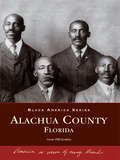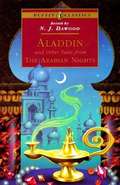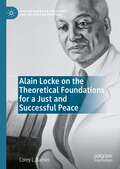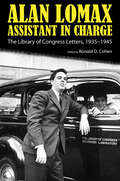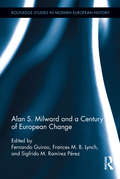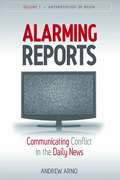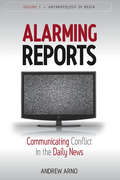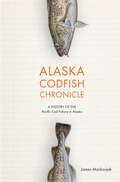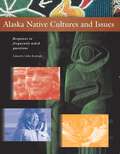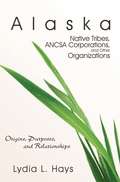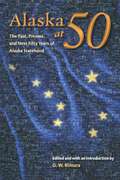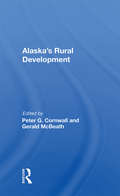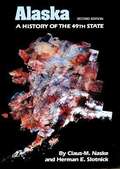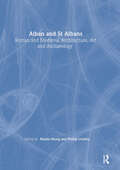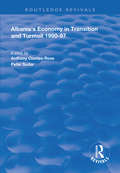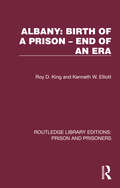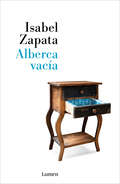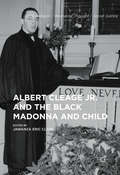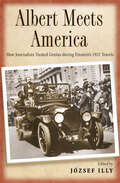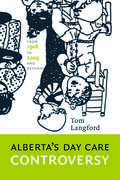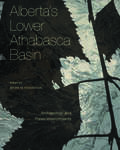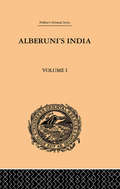- Table View
- List View
Alachua County, Florida (Black America Series)
by Lizzie Prb JenkinsAlachua County's African American ancestry contributed significantly to the area's history. Onceenslaved pioneers Richard and Juliann Sams settled in Archer as early as 1839. They were former slaves of James M. Parchman, who journeyed through the wilderness from Parchman, Mississippi. They and others shaped the county's history through inventions, education, and work ethics based on spirituality. This book shows people working together, from the early1800s rural farm life, when racial violence was routine, until African Americans broke the chains of injustice and started organizing and controlling civic affairs.
Aladdin and Other Tales from the Arabian Nights (Puffin Classics)
by N. J. DawoodThe ragamuffin Aladdin finds an old lamp which makes his fortune; a prince disappears on a flying horse; A falcon proves wiser than a king...These tales of kings and princes, magicians, and talking beasts, which were daily entertainment in India, Persia and Arabia over a thousand years ago, are retold especially for children in this vivid, fresh collection.
Alain Locke on the Theoretical Foundations for a Just and Successful Peace (African American Philosophy and the African Diaspora)
by Corey L. BarnesAlain Locke is most known for his involvement in the Harlem Renaissance. However, he received his PhD in philosophy from Harvard University in 1918, and produced a very large corpus of philosophical work. His work shows him to have been a sophisticated philosopher who thought through practical and theoretical problems regarding the nature of cosmopolitanism, democracy, race, value, religion, art, and education. Although Locke’s philosophical work has been discussed in parts, there has been no theorizing about how his different philosophical commitments fit together. In this book Corey L. Barnes begins to systematize Locke’s philosophical thought, showing how his democratic theory, philosophy of race, and value theory are connected to and undergirded by a commitment to cosmopolitanism. In so doing, Barnes unearths aspects of Locke’s thought—for example, his economic thinking—that have not been accorded attention and reimagines parts of his work about which have been theorized, all while bringing Locke into current debates about each subject.
Alan Lomax, Assistant in Charge: The Library of Congress Letters, 1935-1945 (American Made Music Series)
by Ronald D. CohenAlan Lomax (1915-2002) began working for the Archive of American Folk Song at the Library of Congress in 1936, first as a special and temporary assistant, then as the permanent Assistant in Charge, starting in June 1937, until he left in late 1942. He recorded such important musicians as Woody Guthrie, Muddy Waters, Aunt Molly Jackson, and Jelly Roll Morton. A reading and examination of his letters from 1935 to 1945 reveal someone who led an extremely complex, fascinating, and creative life, mostly as a public employee.While Lomax is noted for his field recordings, these collected letters, many signed "Alan Lomax, Assistant in Charge," are a trove of information until now available only at the Library of Congress. They make it clear that Lomax was very interested in the commercial hillbilly, race, and even popular recordings of the 1920s and after. These letters serve as a way of understanding Lomax's public and private life during some of his most productive and significant years. Lomax was one of the most stimulating and influential cultural workers of the twentieth century. Here he speaks for himself through his voluminous correspondence.
Alan Moore, Out from the Underground: Cartooning, Performance, and Dissent (Palgrave Studies in Comics and Graphic Novels)
by Maggie GrayThis book explores Alan Moore's career as a cartoonist, as shaped by his transdisciplinary practice as a poet, illustrator, musician and playwright as well as his involvement in the Northampton Arts Lab and the hippie counterculture in which it took place. It traces Moore's trajectory out from the underground comix scene of the 1970s and into a commercial music press rocked by the arrival of punk. In doing so it uncovers how performance has shaped Moore's approach to comics and their political potential. Drawing on the work of Bertholt Brecht, who similarly fused political dissent with experimental popular art, this book considers what looking strangely at Alan Moore as cartoonist tells us about comics, their visual and material form, and the performance and politics of their reading and making.
Alan S. Milward and a Century of European Change (Routledge Studies in Modern European History)
by Fernando Guirao Frances M. B. Lynch Sigfrido M. Ramírez PérezThe main purpose of the book is to introduce the work of Alan S. Milward and to acknowledge the full magnitude of his scientific contribution to contemporary British and European history. The book is a collection of essays which provide a better understanding of Alan Milward’s extensive intellectual work for future scholars and facilitate the knowledge and transmission of his published work to present and future generations of students, scholars in the various disciplines concerned, and the general public. The series of original contributions which this book contains are related to or reflect critically upon Milward’s own contributions to the fields of political, diplomatic, and socio-economic history, political science, economics, international relations, and European Studies in general. This book honors Alan Milward through a better understanding of his many pioneering contributions in the fields of contemporary European history in general, and the history of European integration in particular. Although the volume does not aim to be a substitute for Milward’s work itself, it illuminates and assesses his creative process along fifty years of continued and intense work, as well as the impact of his main work, and the continuing relevance of his main theses today.
Alarming Reports
by Andrew ArnoNews stories provide an essential confirmation of our ideas about who we are, what we have to fear, and what to do about it: a marketplace of ideas, shopped by rational citizen decision makers but also a shared resource for grounding our contested narratives of identity in objective reality. News as a fundamental social process comes into being not when an event takes place or when a report of the event is created but when that report becomes news to someone. As it moves off the page into the community, news discovers - through its interpretations - its reality in the lives of the consumers. This book explores the path of news as it moves through the tangled labyrinth of social identities and asserted interests that lie beyond the page or screen. The language and communication-oriented study of news promises a salient area of investigation, pointing the way to an expansion, if not a redefinition of basic anthropological ideas and practices of ethnography, participant observation, and "the field" in the future of anthropological research.
Alarming Reports
by Andrew ArnoasNews stories provide an essential confirmation of our ideas about who we are, what we have to fear, and what to do about it: a marketplace of ideas, shopped by rational citizen decision makers but also a shared resource for grounding our contested narratives of identity in objective reality. News as a fundamental social process comes into being not when an event takes place or when a report of the event is created but when that report becomes news to someone. As it moves off the page into the community, news discovers - through its interpretations - its reality in the lives of the consumers. This book explores the path of news as it moves through the tangled labyrinth of social identities and asserted interests that lie beyond the page or screen. The language and communication-oriented study of news promises a salient area of investigation, pointing the way to an expansion, if not a redefinition of basic anthropological ideas and practices of ethnography, participant observation, and "the field" in the future of anthropological research.
Alaska Codfish Chronicle: A History of the Pacific Cod Fishery in Alaska
by James MackovjakCod is one of the most widely consumed fish in the world. For many years, the Atlantic cod industry took center stage, but partly thanks to climate change and overfishing, it is more and more likely that the cod on your kitchen table or in your fast food fish fillets came from Alaska’s Pacific Cod Fishery. Alaska Codfish Chronicle is the first comprehensive history of this fishery. It looks at the early decades of the fishery’s history, a period marked by hardship and danger, as well as the dominance of foreign fishermen. And the modern era, beginning in 1976 when the United States claimed an exclusive economic zone around the Alaska coasts, “Americanizing” the fishery and replacing the foreign fleets that had been ravaging the resources in the Gulf of Alaska and the Bering Sea. Today, the Pacific cod fishery is, in terms of poundage, the second largest fishery in Alaska, and considered among the best-managed fisheries in the world. This history is extremely well documented, does not spare details, and is accessible to general readers. It incorporates nearly a hundred photographs and illustrations and is sprinkled with numerous observations from fishing industry journals and reports, even incorporating poems and recipes, making this an especially thorough and unique account of one of Alaska’s most iconic and important industries.
Alaska Native Cultures and Issues: Responses to Frequently Asked Questions
by Libby RoderickMaking up more than ten percent of Alaska's population, Native Alaskans are the state's largest minority group. Yet most non-Native Alaskans know surprisingly little about the histories and cultures of their indigenous neighbors, or about the important issues they face. This concise book compiles frequently asked questions and provides informative and accessible responses that shed light on some common misconceptions. With responses composed by scholars within the represented communities and reviewed by a panel of experts, this easy-to-read compendium aims to facilitate a deeper exploration and richer discussion of the complex and compelling issues that are part of Alaska Native life today.
Alaska Native Tribes,ANCSA Corporations, and Other Organizations: Origins, Purposes, and Relationships
by Lydia HaysLearn about Alaska's unique indigenous people who have lived thousands of years in a subsistence economy and unconquered. See how today's Alaska Native people exhibit remarkable resilience and adaptability despite the arrival of foreigners to Alaska in the mid-1700s, who sought natural resources and brought death and disease that claimed many indigenous lives. Clear descriptions, facts, charts, lists, and maps tell about the 230 Alaska Native tribes and more than 350 Alaska Native-owned for profit and nonprofit organizations that have emerged over the past 65 years. A stunning 25,000 year timeline depicts archeological sites which helped provide the basis for aboriginal land rights in the historic Alaska Native Land Claims Settlement in 1971. Today, Alaska Native people comprise about 20 percent of Alaska's population and their institutions are a major player in Alaska's diverse economy. Easy to read, you will gain an essential understanding about these modern institutions that have been successfully integrated with traditional subsistence values and are improving the lives of Alaska Native people and all of Alaska.
Alaska at 50: The Past, Present, and Future of Alaska Statehood
by Gregory W. KimuraIn 2009 Alaska celebrates its fiftieth anniversary of U.S. statehood. To commemorate that milestone, Alaska at 50 brings together some of today’s most noteworthy and recognizable writers and researchers to address the past, present, and future of Alaska. Divided into three overarching sections—art, culture, and humanities; law, economy, and politics; and environment, people, and place—Alaska at 50 is written in highly accessible prose. Illustrations and photographs of significant artefacts of Alaska history enliven the text. Each contributor brings a strong voice and prescription for the next fifty years, and the resulting work presents Alaskans and the nation with an overview of Alaska statehood and ideas for future development.
Alaska's Rural Development
by Peter G. Cornwall Gerald McBeathThis book examines the social, economic, political, and cultural concerns surrounding the development of rural Alaska. The authors explore the controversy over rural development from a variety of perspectives-some supporting economic development and its implications for rural communities, others arguing for alternative approaches. They raise the issues of external control over local development and the effects of the boom-and-bust cycle often associated with rural change. Part 1 surveys the economic development of Alaska's resources, providing an historical overview of its fur, timber, and fishing industries and examining the current importance of oil, gas, minerals, and agricultural products. The section concludes with a discussion of the unique patterns of trade between Alaska and Asia. The second part turns to the organizations that have been, and are presently, the major vehicles for development-the village and regional corporations that grew out of the Alaska Native Claims Settlement Act of 1971 and the non-profit organizations responsible for social services and education. The authors also discuss the increasingly important role of governmental institutions. The final section considers the conflict between the goal of economic development and traditional Native values of subsistence and cultural preservation. The authors ask whether the development of Alaska's rural regions must take place at the expense of the traditional lifestyle and cultural distinctiveness of Native society.
Alaska: A History of the 49th State (Second Edition)
by Claus-M. Naske Herman E. SlotnickThe largest by far of the fifty states, Alaska is also the one of greatest mystery and diversity. Geological forces have made its more than half-million square miles a region of breathtaking beauty and awesome contrasts. And, as Claus-M. Naska and Herman E. Slotnick show in this revised and updated edition of their book, the history and development of Alaska’s peoples has matched the diversity of its landscapes and seascapes.
Alaska: A Man from Kanatak (The Story of Paul Boskoffsky)
by Lloyd Mattson Paul BoskoffskyALASKA: A Man from Kanatak first appeared in 2002. The warm reception accorded the book in Alaska and beyond led us to this revision book. The first edition told of the grave illness of Paul and Nattie's lovely daughter, Jewell. This revision tells of her sad home going in May, 2004 and includes some of her writings.
Alban and St Albans: Roman and Medieval Architecture, Art and Archaeology (The British Archaeological Association Conference Transactions)
by Philip Lindley Martin HeingThis is a collection of eighteen papers presented at a conference that was held at the Hatfield Campus of the University of Hertfordshire with 122 members and guests from the United Kingdom, the United States of America, Germany and Norway were present. The papers are on the research on various aspects of the art and architecture of the abbey, at St Albans and provides an ideal forum for bringing together many aspects of the abbey’s history.
Albania's Economy in Transition and Turmoil 1990-97 (Routledge Revivals)
by Petar Sudar Anthony Clunies-RossFirst published in 1998, the contents of this book is the result of a series of studies by several Albanian scholars, in cooperation with contributors of differing nationalities, on various aspects of the Albanian economy during its ‘transition to market’. This study’s multiple aim is to provide an accessible body of information for outsiders interested in Albania ; to provide locally based teaching material for Albanian economics students; and to also clarify policy issues.
Albany: Birth of a Prison – End of an Era (Routledge Library Editions: Prison and Prisoners)
by Roy D. King Kenneth W. ElliottOriginally published in 1977, Albany: Birth of a Prison - End of an Era attempts to document and analyse some of the changes which happened in the first five and a half years of the prison’s opening and as far as possible account for them. Albany was planned and built as a medium-security establishment but the growth in the prison population meant it ended up, in part, as a maximum-security unit. At the time the prison was notorious, after a stormy series of incidents culminated in an alleged mass escape attempt and a riot, it had become known as the ‘jail of fear’ in which ‘mafia groups’ were said to ‘terrorize’ staff and prisoners alike. Despite the account inevitably being incomplete, it was hoped that lessons could be drawn, both for social research and social policy in regard to prisons.
Alberca vacía
by Isabel ZapataEn Alberca vacía, Isabel Zapata nos recuerda que la vida se descubre y se significa en la danza de lo inmediato, en cada gesto, en cada duelo, en cada plato de lentejas. -Prólogo de Alejandro Zambra- No son cartas febriles, aunque en todas late una intensidad dulce y melancólica. Juntas componen una cartografía diversa: van de la traducción a la maternidad y la pandemia, de los subrayados como formas de ternura al germen de futuro que se incuba en toda alberca vacía. Encontramos también una historia de las virtudes perrunas, un pequeño tratado sobre la libertad y el decoro a propósito de los bufets, y una lección, a vuelo de pájaro, sobre las posibilidades de migrar dentro de nuestra propia casa. «Estos ensayos nos interpelan, a veces de forma directa, otras veces velada, como con una amabilidad tácita.» -Alejandro Zambra
Albert Cleage Jr. and the Black Madonna and Child (Black Religion/Womanist Thought/Social Justice)
by Jawanza Eric ClarkIn this collection, black religious scholars and pastors whose expertise range from theology, ethics, and the psychology of religion, to preaching, religious aesthetics, and religious education, discuss the legacy of Albert B. Cleage Jr. and the idea of the Black Madonna and child. Easter Sunday, 2017 will mark the fifty year anniversary of Albert B. Cleage Jr. 's unveiling of a mural of the Black Madonna and child in his church in Detroit, Michigan. This unveiling symbolized a radical theological departure and disruption. The mural helped symbolically launch Black Christian Nationalism and influenced the Black Power movement in the United States. But fifty years later, what has been the lasting impact of this act of theological innovation? What is the legacy of Cleage's emphasis on the literal blackness of Jesus? How has the idea of a Black Madonna and child informed notions of black womanhood, motherhood? LGBTQ communities? How has Cleage's theology influenced Christian education, Africana pastoral theology, and the Black Arts Movement? The contributors to this work discuss answers to these and many more questions.
Albert Meets America: How Journalists Treated Genius during Einstein's 1921 Travels
by József IllyThis volume of news articles from Einstein’s first trip to America explores his rise a public figure and the creation of his celebrity persona.When a British expedition confirmed Albert Einstein’s general theory of relativity in 1919, the news catapulted the German physicist to global fame. Two years later, he joined a fund-raising tour through the United States—a country he’d never seen before—gathering support for the Hebrew University of Jerusalem. His lectures in New York, Princeton, and Chicago, and comments on the Jewish presence in Palestine, made Einstein one of the first media stars. In Albert Meets America, József Illy presents a fascinating compilation of media stories written during Einstein’s trip that cover his science, his Zionism, and the anti-Semitism he encountered. Traveling with Einstein from headline to headline, readers experience his emotional connection with American Jews and his frustration at becoming world famous even though his theories were not truly understood.This collection gives readers an intimate glimpse into the life of one of the world’s first modern celebrities and a unique understanding of the media’s power over both its subject and its audience.
Albert Schwenn's Memories of the Waffen-SS: An SS Cavalry Division Veteran Remembers
by Rolf Michaelis Albert SchwennA firsthand account from a member of the SS Cavalry Division, and SS Cavalry Training and Replacement Battalion
Alberta's Day Care Controversy: From 1908 to 2009 and Beyond
by Tom LangfordDay care in Alberta has had a remarkably durable history as a controversial issue. Since the late 1950s, disputes over day care programs, policies, and funding have been a recurring feature of political life in the province. Alberta’s Day Care Controversy traces the development of day care policies and programs in Alberta, with particular emphasis on policy decisions and program initiatives that have provoked considerable debate and struggle among citizens. For most of Alberta’s first fifty years as a province, day care was treated as a private rather than a public issue. Beginning in the late 1950s, however, debates about day care began to appear regularly on the public record. Dr. Tom Langford brings to light the public controversies that occurred during the last four decades of the twentieth century and the first decade of the new millennium, placing contemporary issues in historical context and anticipating the elements of future policy struggles.
Alberta's Lower Athabasca Basin: Archaeology and Palaeoenvironments
by John W. Ives Alwynne B. Beaudoin Angela M. Younie Brian M. Ronaghan Brian O. Reeves Duane G. Froese Elizabeth C. Robertson Eugene M. Gryba Gloria J. Fedirchuk Grant M. Clarke James A. Burns Janet Blakey Jennifer C. Tischer Laura Roskowski Luc Bouchet Murray Lobb Nancy Saxberg Raymond J. Le Blanc Robert R. Young Robin J. Woywitka Stephen A. Wolfe Thomas V. Lowell Timothy G. FisherOver the past two decades, the oil sands region of northeastern Alberta has been the site of unprecedented levels of development. Alberta's Lower Athabasca Basin tells a fascinating story of how a catastrophic ice age flood left behind a unique landscape in the Lower Athabasca Basin, one that made deposits of bitumen available for surface mining. Less well known is the discovery that this flood also produced an environment that supported perhaps the most intensive use of boreal forest resources by prehistoric Native people yet recognized in Canada. Studies undertaken to meet the conservation requirements of the Alberta Historical Resources Act have yielded a rich and varied record of prehistoric habitation and activity in the oil sands area. Evidence from between 9,500 and 5,000 years ago—the result of several major excavations—has confirmed extensive human use of the region’s resources, while important contextual information provided by key geological and palaeoenvironmental studies has deepened our understanding of how the region’s early inhabitants interacted with the landscape. Touching on various elements of this rich environmental and archaeological record, the contributors to this volume use the evidence gained through research and compliance studies to offer new insights into human and natural history. They also examine the challenges of managing this irreplaceable heritage resource in the face of ongoing development. Contributors: Alwynne Beaudoin, Angela Younie, Brian O.K. Reeves, Duane Froese, Elizabeth Roberston, Eugene Gryba, Gloria Fedirchuk, Grant Clarke, John W. Ives, Janet Blakey, Jennifer Tischer, Jim Burns, Laura Roskowski, Luc Bouchet, Murray Lobb, Nancy Saxberg, Raymond LeBlanc, Robert R. Young, Robin Woywitka, Thomas V. Lowell, and Timothy Fisher
Alberuni's India: An Account of the Religion, Philosophy, Literature, Geography, Chronology, Astronomy, Customs, Laws and Astrology of India: Volume I
by Edward C. SachauThis is Volume IX of eleven in a collection of India: History, Economy and Society. Originally published in 1910, this is the first part of an account of the religion, philosophy, literature, geography, chronology, astronomy, customs, laws and astrology of Alberuni's India about A.D. 1030.
